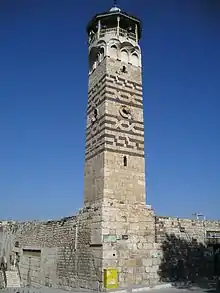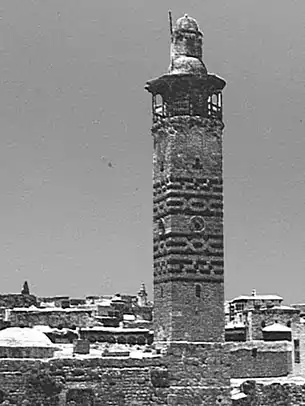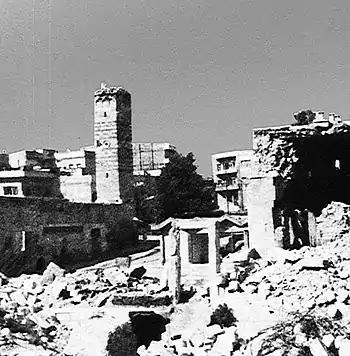Nur al-Din Mosque
The Nur Al-Din Mosque (Arabic: جَامِع نُور ٱلدِّين, romanized: Jāmiʿ Nūr ad-Dīn, transliteration: Jami Nur al-Din) is a Zengid-era mosque in Hama, Syria.[1] It was founded by Nur al-Din in 1163-64 CE. It also contained a historic minbar from the same date, which is now held at the local Hama Museum.[2]
| Nur Al-Din Mosque جَامِعُ نُورِ الدِّينِ | |
|---|---|
 The minaret of Nur al-Din Mosque | |
| Religion | |
| Affiliation | Islam |
| Region | Levant |
| Status | Active |
| Location | |
| Location | Hama, Syria |
| Geographic coordinates | 35°8′6″N 36°45′9″E |
| Architecture | |
| Type | Mosque |
| Style | Zengid |
| Completed | 1172 |
| Specifications | |
| Minaret(s) | 1 |
| Materials | Basalt, Limestone, Tiles |
The mosque was profoundly damaged in the 1982 shelling of the city and subsequently restored to its current state.
Prior to 1982 shelling
After shelling
References
- Nur al-Din Mosque Archnet Digital Library.
- Hafian, Waal. "Minbar". Discover Islamic Art, Museum With No Frontiers. Retrieved October 18, 2020.
Bibliography
- Rihawi, Abdul Qader (1979). Arabic Islamic Architecture: Its Characteristics and Traces in Syria. Publications of the Ministry of Culture and National Leadership.
This article is issued from Wikipedia. The text is licensed under Creative Commons - Attribution - Sharealike. Additional terms may apply for the media files.





